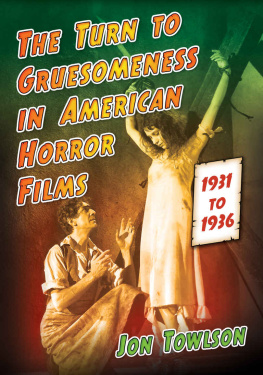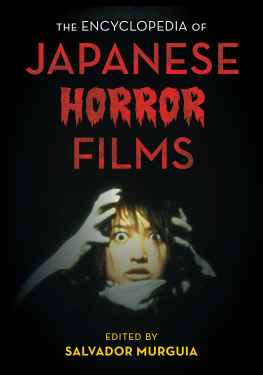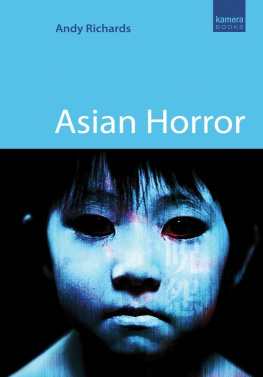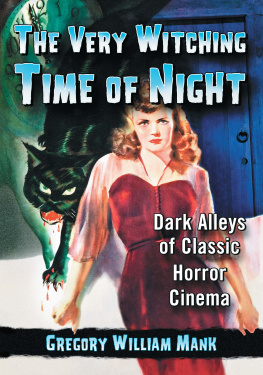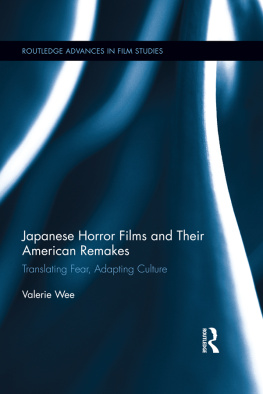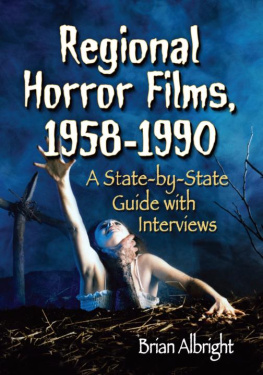Also by JON TOWLSON
Subversive Horror Cinema: Countercultural Messages of Films from Frankenstein to the Present (McFarland, 2014)
The Turn to Gruesomeness in American Horror Films, 19311936
JON TOWLSON

McFarland & Company, Inc., Publishers
Jefferson, North Carolina
LIBRARY OF CONGRESS CATALOGUING DATA ARE AVAILABLE
BRITISH LIBRARY CATALOGUING DATA ARE AVAILABLE
e-ISBN: 978-1-4766-2639-0
2016 Jon Towlson. All rights reserved
No part of this book may be reproduced or transmitted in any form or by any means, electronic or mechanical, including photocopying or recording, or by any information storage and retrieval system, without permission in writing from the publisher.
Front cover: Bela Lugosi and Arlene Francis in Murders in the Rue Morgue, 1932 (Universal Pictures/Photofest)
McFarland & Company, Inc., Publishers
Box 611, Jefferson, North Carolina 28640
www.mcfarlandpub.com
For Donato Totaro,
who inspired this book.
Table of Contents
Preface
Our understanding of thirties horror has changed somewhat in recent years. Until not long ago we had forgottenor were not fully aware ofhow shockingly graphic the early thirties horror films actually were. Only in the age of the DVD have we been able to view these films in uncensored versions, and become aware of previously censored and deleted scenes, changed and tacked-on endings, reshoots and added scenes that changed or diluted the original versions of classic horror films and gave previous generations of horror fans and critics the impression that the thirties horror film was safer and more reassuring to audiences than it actually was. Film historians and fans (thanks partly to a raised awareness of preCode Hollywood cinema) are now beginning to separate their nostalgia for Universals family-friendly monster rally horror films of the forties from their growing appreciation of the gruesome and brutal nature of the thirties cycle. Certainly the term gruesomeness is one that crops up again and again in the censor reports, film reviews, marketing and publicity materials produced by the studios (which routinely played up the sensationalist aspects of the films, including their gruesomeness) and industry journals of the 1930s; it is arguably the defining characteristic of thirties horror, and undoubtedly key to its popularity with audiences of the time.
The infamous scene in Murders in the Rue Morgue (1932) where Lugosi strings up a prostitute on a cross while he takes samples of her rotten blood, might, for example, be seen as a precursor of torture porn; it is certainly strikingly similar, in the way it is staged, to an equally infamous scene in TheTexas Chain Saw Massacre (1974) in which Leatherface (Gunnar Hansen) carves up a body, while another victim dangles from the meat hook behind him. Both are shocking examples of Grand Guignol. This raises the question: Is the thirties horror film more akin to graphic modern horror than is often thought?
However, many critics have in the past drawn sharp distinctions between the classic (1930s1940s) and modern (1960spresent) horror film, claiming that whereas the former seeks to reaffirm the status quo (the classic horror film inevitably ends with the monster destroyed and normality restored), the modern apocalyptic horror film (from Psycho [1960] onward) is, by contrast, open-ended, nihilistic, paranoid, and subversive. But, despite their restorative endings, horror films of the thirtieswith their social outcast monsters, mad scientists, torture chamber imagery, libidinous maniacal killers and often overt sadismposed considerable challenges to censors and audiences. Moreover, by closely examining the so-called restorative endings of films like The Black Cat (1934), The Raven (1935) and Mad Love (1935), these endings can be revealed as tacked-on, formulaic (usually as a sop to the Production Code and state censors) and unconvincing, running counter to the main body of the films: they simply dont fit. In some cases (Frankenstein [1931]), Freaks [1932]) endings were changed after preview screenings in order to provide audiences with closure and reassurance where none had previously existed.
So How Safe and Reassuring Were the Thirties Films Really?
To explore such questions is the intention of this book. The Turn toGruesomeness in American Horror Films, 19311936 challenges the critical opinion that classic horror is inherently conservative as defined by endings which restore normative order; instead it argues that the essential characteristics of thirties horror are its gruesomeness and brutality, and that happy endings in the thirties cycle are almost entirely lacking conviction. In order to do this it looks first at how the genre was formulated in the thirties and examines the evolution of the classic horror film from various perspectives.
Chapter 1, Nightmare pictures, charts the emergence of the thirties cycle in an industrial context, showing how various socio-economic stresses during the Great Depression, censorship controversy over sex and crime films, declining audiences and growing opposition to unfair business practices, formed a backdrop of rupture and contradiction during horrors first golden age. This chapter draws on trade journals of the day to track the cycle from Dracula (1931) and Frankenstein (1931) to its becoming a firmly established niche product by the mid-thirties. At the same time, the trade journals also report on the growing concerns about this gruesome cycle by state censors, church groups and exhibitor organizations. This chapter thus attempts to contextualize the emergence of horror in light of the politics of the industry of the time, and how these factors almost led to the cycle being killed off in 1932 before jungle movies revived the horror cycle at the box office with the extraordinary success of King Kong (1933); thereafter the genre continued to thrive on sadism despite moving away from its gothic roots.
Chapter 2 goes on to show how cash-strapped studios pushed for increasingly gruesome and sensational screen content to attract audiences, while simultaneously placating the Hays Office with moral endings, and how, in conjunction, the production practices pioneered by Irving Thalbergsuch as audience previews and retakesalso helped shape the form of the thirties cycle as we know it. Critics of the genre at the time called such studio tactics five reels of transgression followed by one reel of retribution (the title given to this chapter). This chapter thus takes the studio perspective on the burgeoning horror cycle, from Universals initial appropriation of the genre, to other studios adoption of it.
In their bid to attract audiences through sensational content, studios often flouted the Production Code; however, horror pictures (in contrast with sex pictures and underworld crime movies) were of only mild concern to the Hays Office at the start. Later, though, the rigid enforcement of the Production Code under Joseph Breen saw horror increasingly censored in terms of its gruesomeness and brutality to the point where, by 1936, the Code had an overbearing influence on actual story content and plot constructionas can be seen in Draculas Daughter, The Walking Dead and The Devil Doll (all 1936)effectively emasculating the genre. Chapter 3, Brutality, horror and gruesomeness, thus documents from the censors perspective the changing ways in which the Hays Office responded to gruesomeness in the thirties cycle, from relatively light interference in the early days to heavily influencing the allowable level of gruesomeness after July 1934. It charts an arc of trajectory from
Next page
